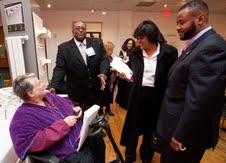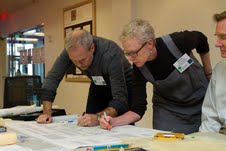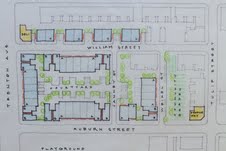Should Philadelphia homes have first floors that are accessible to all?
Advocates for equal opportunity access to housing say that all new homes in Philadelphia should be built with ground floors that make it possible for anyone to spend time there.
But a builder and past president of the Building Industry Association of Philadelphia says that while this may be an excellent choice for some homeowners, other buyers would rather use their money and/or ground floor space for other amenities, and it shouldn’t be up to City Hall to make that choice.
The concept advocates are fighting for is called visitability, and the word means just what it sounds like: Able to be visited. A visitable home has at least one entrance with no steps, at least a half-bath on the ground floor that is large enough to accommodate a wheelchair, and doorways and hallways that are also wide enough for a person in a wheelchair to pass through.
This doesn’t mean that the entire home is accessible to disabled people, said Damon Martin, an independent living specialist with Liberty Resources, a Philadelphia non-profit that advocates for independent living for people with disabilities. Visitability is not a concept that guides the building of houses for the disabled. “It is so that disabled people who have friends who are not disabled can come over and visit them,” said Martin, who has cerebral palsy and mostly uses crutches, but sometimes a wheelchair, to get around.
Local advocates hope to persuade those in city government and planning, those who design houses, and those who plan to build a home that visitible homes make everyone’s life better, and having more of them would make living in Philadelphia a richer experience.
For a person who uses a wheelchair, for example, spending time anywhere that doesn’t have these features may be difficult at best. Having homes and buildings built to these standards means that people with difficulty moving around have better access to their communities, and can better interact with their neighbors.
But these homes and buildings make life easier for everyone, said Nancy Salandra, director of independent living services at Liberty Resources. A person with no inherent present physical limitations may suffer a temporary injury, or be carrying a child or groceries. They may also develop mobility issues as they age, she said.
That’s why advocates for the aging are also talking about the visitibility concept. “If you look at the traditional row home in Philadelphia, it’s Peter Pan housing, “ said Susan I. Klein, director of housing at the Philadelphia Corporation for Aging. “It’s great for people who never grow old, and if they fly, it’s even better.
A house with the laundry in the basement, the kitchen on the first floor, and the bathroom on the second floor just doesn’t work if aging or anything else is making it difficult to do stairs, Klein said.
By Klein’s way of thinking, these houses are actually making people disabled.
Professionals who help people with mobility issues used to define disabilities in terms of diseases people had, she said. But now, the term is more often used to mean that people literally cannot do something, such as enter a home or get to the toilet. “So many times, it is the design of the house that creates this disability,” she said. “If you took the same person and put them in a different environment, they would be able to take care of their own needs.
Regardless of age, a person who breaks a hip may be able to stay in a home with a bathroom on the first floor and a no-step entrance while they recover, she said. That same person – without those amenities – may have to recuperate in a nursing home.
Houses built visitable now may make it easier for the young, healthy person buying them today to stay put through their old age, Klein said, which is why the visitability concept was a topic at the Lawton Conference on Urban Aging, held last month in Philadelphia.
At the conference, Fourth District Councilman Curtis Jones told a funny story about a not-at-all-funny experience he had on the campaign trail that made him start thinking about visitability. He slipped on the ice, went horizontal like Fred Flintstone does before he falls, and then fell on his back. His injury resulted in sciatica.
Councilman Jones tells of his ordeal – and how it made him rethink visitability and accessibility.
Salandra chairs the Philadelphia Visitability Task Force – a group that has been pushing visitability in Philadelphia for more than a decade. The Task Force wants Jones and other council members to create visitability law. “We have one goal,” Salandra said. “To get legislation in the City of Philadelphia so any new housing built would have to be visitible.”
There have been victories. Any homes that are built with money from the City’s Housing Trust Fund – money generated by fees charged for recording deeds – must be visitable. But, Salandra said, while bills that would have required all new housing to be visitable have been introduced to city council, they have gone nowhere.
The visitability task force is trying anew. Klein said that they submitted comments about the proposed new zoning code, asking for a change that any development of 10 houses or more require at least half to be visitable.
Zoning Code Commission Executive Director Eva Gladstein said at the aging conference that so far, the new code does not include new visitability proposals. It does contain a proposal, which has proven controversial, that would allow homes to contain a second living unit so that a person who needs extra assistance can have a caretaker live at their residence.
Gladstein at the aging conference, speaking about, among other things, accessory residences.
In late October, the Community Design Collaborative, the City of Philadelphia Office of Housing and Community Development and the Philadelphia Visitability Committee held a day-long visitability charrette where architects, designers and others re-imagined the Philadelphia row house in visitable form. The results were presented at day’s end to city council and other city leaders, and are also being compiled into a document that will also be delivered to them.
But both that visitability charrette and the urban aging conference aimed to promote visitability in another way: Convincing people who design or build housing that building in a visitable way makes good sense, even if no ordinance requires it.
Diana Myers, who leads the housing and community development consulting firm Diana T. Myers and Associates, helped facilitate the visitability charrette. “We walked out of there with 40 architects thinking about this,” she said. “My hope is they will introduce the concept to their clients.”
Rachel Schade, a principal and Schade and Bolendar Architects, said after participating in the charrette, she will definitely be bringing up visitability with her clients.
“What brought it home was the presentation before (the charrette) started. At some point or other, 80 percent of us are going to require some level of accessibility,” she said.
A house built to this standard would have helped a friend who had to go into a nursing home for three months while healing from injuries sustained falling off a latter because he couldn’t maneuver around his row home alone while his wife was at work, Schade said. But it would also make her life as a bicyclist easier. “It’s a convenience all sorts of people could use,” she said.
The teams designed a rowhome development for a block in East Kensington. Schade’s team did not put a ramp at the front entrance – they thought it was important for the buildings to extend to the sidewalk to keep the traditional aesthetic and for the privacy the steps provide, she said.
They designed a courtyard development with a grocer’s alley – a skinny space between two houses that belongs to both. In this case, the alley was a ramp with a gradual grade that allowed for a visitable entrance at the back.
Another style the team came up with had a small setback of three feet with a single step at the front and a short ramp at the side of the house.
Schade said it is much easier designing a house this way than retrofitting one later.
Salandra said the most it would cost to make a house visitable is about $2,000, the cost for special grading and a wheelchair accessible, first floor bath. And buyers want first floor baths, anyway, she said.
If visitability advocates hope to persuade Brett Altman, president of Allied Construction Services and past president of the Philadelphia Building Industry Association, of the merits of the program, they will first have to persuade his customers.
Altman, who also attended the charrette said that visitable buildings can be great for some people, but he does not think city government should require more homes to be built that way.
And he disagrees with the $2,000 price tag Salandra and others assigned to making a home visitable.
Altman has built visitable homes in projects subsidized by the city’s housing fund For one development he built in Mantua about a year ago, visitability added about $10,000 to each home’s cost, he said. A lot of the cost depends on the grade at the site, Altman said.
There are other non-monetary costs as well, he said. “Somebody might be giving up a kitchen pantry or a closet to make more room in the hallway,” he said.
If Philadelphia required all new houses to be visitable, Altman said a prospective buyer might well choose a house in the same price range outside the city, where the first floor powder room was smaller and the kitchen had a pantry.
Klein said she thinks Altman is missing a potential market. But Altman says so far, there is no demand trend.
“If I’m custom building a house, and the buyer says ‘I want it to be visitable,’ I am happy to do that,” Altman said. “But if I’m speculating a house, I would put my money into features other than visitability in order to market a house.”
Contact the reporter at kgates@planphilly.com.
WHYY is your source for fact-based, in-depth journalism and information. As a nonprofit organization, we rely on financial support from readers like you. Please give today.









